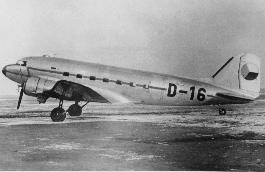 |
D-47 Douglas C-47 was crewed by three or four men or women. Empty weight of 8 200 kg, span 29.11 m, length 19.43 m. Powered by two Pratt Whitney R-1830-92 of 1200 hp each ,top speed 368 km.p.h., service ceiling 6 680 m and range 2 400 km. Alclad steel-framed fuselage, fin and tailplane, steel-framed control surfaces covered by fabric. Dural cowling.
|
| |
|
|
Douglas C-47 is a military version of DC-3. One machine of this type was bought by the Cz Gvt in the USA and landed in Prague on Mar 12, 1939 - three days before the Nazis occupied the rest of Bohemia and Moravia.. Interior of C-47s had to be refitted first in the Avia Comp and from May 1946 were Dakotas in use of the Cz Aerliner as on crossboard as inboard routes carrying crew of three and twenty one passengers.
|
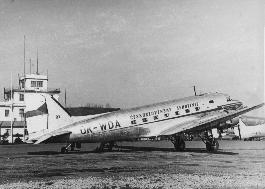 |
| |
|
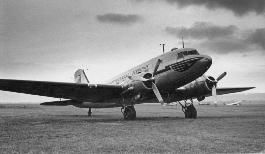 |
Douglas C-47 " Dakotas " of the Czechoslovak Airliner were mostly silver. 22 machines used by it in the 1946 - 1960 period bore a black banner "OK LINER" near the port front door and on the wing. The fuselage is of semicircular-dural-mould construction. Three-blade fully articulated propellers.
|
| |
|
|
Morane Saulnier M. S. 230. Three machines were flown in Cz Flying Clubs after WWII as tugplanes. Very popular among pilots. Wood-framed wing partly covered by plywood plus fabric, Steel-framed fuselage, fin, tailplane as well as tail control surfaces covered by fabric. Sheet metal plate cowling. Powered by a 230 radial Salmson 9 Ab engine driving a two-blade wooden propeller. Top speed 205 km.p.h., service ceiling 6 000 m, range 600 km. Empty weight 820 kg, length 6.90 m, span 10.70 m. The M.S.230s flown by the Cz sporting pilots were silver on all surfaces.
|
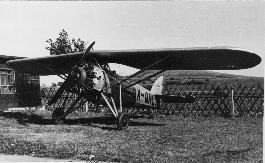 |
| |
|
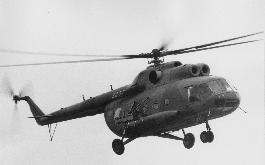 |
Mi 8 Hip is a mid-weight-class helicopter built from 1964 serving in the Cz AF till 1988. Empty weight of 7 420 kg, powered by two Izotov TV-2-117As of 1500 hp each. Top speed 230 km.p.h., service ceiling 4 500 m, range 650 km. Fuselage of a metal monocoque construction, some metal parts. Four-blade main rotor, the tail one is of three-blades. Fixed undercarriage. Crew of two or three, load of 3 tons. Diameter of the main rotor 21.29 m. The Mi 171Ss delivered in 2005 - engines of 2200 hp and a night-sight system, some with a ramp and a crane of 300 kg on their starboard.
|
| |
|
|
Mi-4 was the first helicopter used by the Cz AF for transport duties from Mar 1956 to 1984. Crewed by two or three, engine of 1 700 hp, diameter of a three-blade composite main rotor 21 m, a wooden propeller of a tail one. Empty weight 4 900 kg, loaded one 7 700 kg. Top speed 185 km.p.h, service ceiling 5500 m, range 400 km. A land rover or a manned gun aboard. Used for para dropping or laying mines too.
|
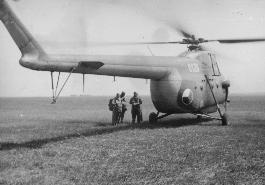 |
| |
|
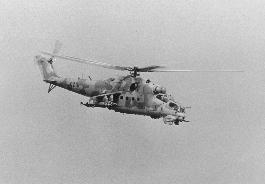 |
Mi-24 Hind is a two-engined multi-purpose helicopter used not only for attacking ground or air targets by guided missiles or rackets, but also for transport of sixteen GIs or load of 2 500 kg weight. A composite five-blade propeller of a main rotor, a tail one is a three-blade composite too, both driven by two GTD-3s of 1 500 hp each, top speed of 310 km.p.h., service ceiling 4 500 m, range 720 km, empty weight of 4 700 kg. Diameter of the main rotor 17.05 m, retracted undercarriage, crew of three. Entering service in CzAF in 1978, the new ones of the No 35 version equipped with the night-sight system and powered by two strenghtened Klimov TV-3-117s of 2200 hp each.
|
| |
|
|
Aero L-39 ZA Albatros armament`s variations -four racket containers for 64 ones or two guided missiles R-35V infra or four PK3 machine gun pods of three barreled each, 9360 rounds.p.m or a removable GS-23 cannon of 3100 rds.p.m. Service ceiling 11 300 m, range 1 200 km, span 9.46, length 12.32 m. Take-off weight 5600 kg.
|
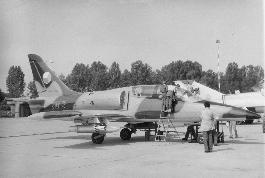 |
| |
|
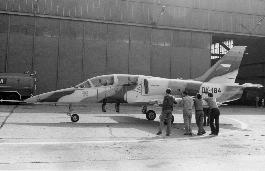 |
Aero L-39 Albatros was designed to bounce also on grass. An L-39`s air intake is smaller and its undercarriage less robust in comparison with the L-39ZA type, but the empty weight of 3 300 kg, 824 kg fuel, AI-25 TL engine of thrust 16.90 kN and top speed of 755 km.p.h are commonalities. Take-off weight of 4 643 kg and landing one 4 500 kg. Alclad steel-framed wings, fuselage as well as tailplane, fin and control surfaces. The L-39 type was put into use in the Kosice Military Academy in 1973. As L-39C and V, as ZA and MS versions were struck off charge in 1992.
|
| |
|
|
A shot of a MiG-21 P strike fighter used for all-weather-round-the-clock operations. The pilot Boleslav Povolny wearing his pressure suit and helmet getting aboard is being helped by a mechanic holding a helmet visor. After seating and strapping himself, the pilot links the visor to the helmet and connects the seat to the oxygen system. Two hoses are linked to the of the pilot´s flying suit. The first longer one less visible has a hook to be fastened to the seat and in the case of dehermetization or ejection protects the pilot from his death. The second hose that can be seen clearly, is connected to the seat mechanism and produces pressure for legs and belly parts of the pilot suit. The pilot`s brain is being protected from blood shortage as well as surge stemming from g-loads while the jet performing maneuvres is.
|
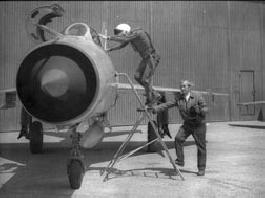 |
| |
|
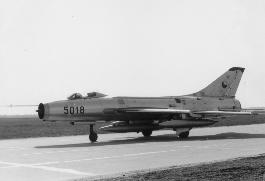 |
Su 7 – Cz AF used 102 Su-7BM from Apr 15, 1964 to 1990 first bare-metal colored. Steel-framed wing, fuselage as well as fin, tailplane and control surfaces skinned by a special alloy of aluminium. Dural cowling. Engine centroplane housed. Main undercarrige retractable into the wing, a nose wheel into a fuselage. Span 9.31 m, length 15.75 m, empty weight 8 620 kg. AnAL-7F-1-100 engine of the thrust of 98 kN, top speed 2 200 km, service ceiling 18 200 m and range 330 km. Armed by two 30 mm cannons mounted in wing roots and missiles on the special racks.
|
| |
|
TEXT
- The Licence Agreement on the MIG-15 production between the United States of Socialist Republic /USSR/ and Czechoslovakia was signed on April 15, 1951. The number of 821
S-102s powered by the RD-45F engine of the 22.26 kN thrust and 2013 UTI MIG 15 dual control trainers were built in the Aero Vodochody Company. The S-102 type served with
the Czechoslovak Air force till 1970.
- MiG PF fitted by a radar was not built in this country.The round-the-clock readiness was held on this type in all weather conditions from the 1956 year.
- MIG 19S had been delivered dismantled and as an pattern machine was flown on February 6, 1958. Radar-equipped. The first Czechoslovakia-built machine was flight-tested on October 30, 1959. The 105 production MIG 19S built in December 1961 was the last one. Two RD-9B engines of the thrust of 56.38 kN each. The MIG 19s of the P - radar and cannon - as well as PM versions - radar and ray-guided-missiles- were imported from the Soviet Union. The total number of 182 MIG 19s of all the versions mentioned above served were withdrawn from use of the Czechoslovak AF on June 2, 1972.
- MIG 21 was the first type exceeding the speed limit of 2 000 km.p.h.
194 MIG 21s of F version powered by a R-11F-300 of 56.38 kN were built by the Aero Vodochody Comp. from April 21, 1962 to 1972. The MIG 21s of other versions were imported. The total amount of 476 MIG 21s of all versions were in service with the Czechoslovak Air Force. The R version of the MIG 21 retired in 1994 and the intended upgrading of MIG 21 MF serving as a staple type of the Czechoslovak Air Defence was not approved. The MIG 21 MFs assigned at the Caslav air base played this role till May 2005, being replaced by the Swedish-built JAS 39 Grippen aircraft.
- 70 MIG 23 BNs were delivered from December 27, 1977 to 1983. Entering service at the Ceske Budejovice airfield on January 2, 1981, this type was being dogged by never ending engine troubles. That reason for the MIG 23 BNs served till June 15, 1994 only.
- Su 7BM delivered from the USSR in the 1963 - 1966 period amounting 100 machines. Used by the Czechoslovakian Air Force till 1992.
- Su 22 M4 and UM3K trainers. The former imported in the number of 50, the latter amounting 8 machines. Both in service till 1992.
- 20 MIG 29s were imported from Soviet Union in 1989 and withdrawn from use on July 1, 1994.
The Czechoslovak Army Staff comprised the number of 163.992 men and women - 26.737 of them served with the Air Defence and 19.517 with the Air Force.
The total number of 342 war planes was as follows :
163 MIG 21s 56 Mi-24 Hind helicopters
64 MIG 23s 130 Mi-2s, Mi-8s Hip and Mi-17s
57 Su 22s 46 transport planes of the these types : An-12, An-24, An-26, An-30, Jak-40, Tu-134 and L-410
107 L-29 and L-39 trainers
After the state of Czechoslovakia had been split into the Czech and Slovak Republics on January 1, 1993, the arsenal was divided into them as follows :
Czech Rep Slovak Rep Czech Rep Slovak Rep
MIG 21 MA/MF 4 13 MIG 21 MF 52 36
MIG 21 R 12 8 MIG 21 US Mongol-B 5 2
MIG 21 UM 19 11 MIG 23 BN 28 0
MIG 21 MF 12 0 MIG 23 ML 17 0
MIG 23 U 7 0 MIG 29 Fulcrum 9 9
MIG 23 UBFloggerC 1 1
Su 22 M4 31 18 Su 22 UM 3K 5 3
Su-25 K 24 12 Su-25 UBK 1 1
L-39 C 17 8 L-39 ZA 17 9
L-39 MS 4 2 L-39 V 4 2
The Slovakian Air Force refused to accept any MIG 23s due to their strucking off charge being in sight. In addition 12 MIG 21Fs, 11 MIG 21 PFM, 2 MIG 21 Us and 7 Su BKLs were assigned to the Slovakian bases.
Arsenal of the Czech Air Force on January 1, 1993 :
80 fighter planes of MIG 21 MF, MIG 23 MF and ML as well as MIG 29 types
72 fighter bombers of the MIG 21 MF, MIG 23 BN, Su 22 M4 and UM3K types and versions
25 fighter bomber Su-25s
26 MIG 21 U and UM at Military Air Academy
76 L-29 and L-39 advanced trainers
122 Mi-2, Mi-8, Mi-17 as well as Mi-24 helicopters
32 Tu-154, Tu-134, An-12, An-24, An-26, An-30 and L-410 of various versions.











